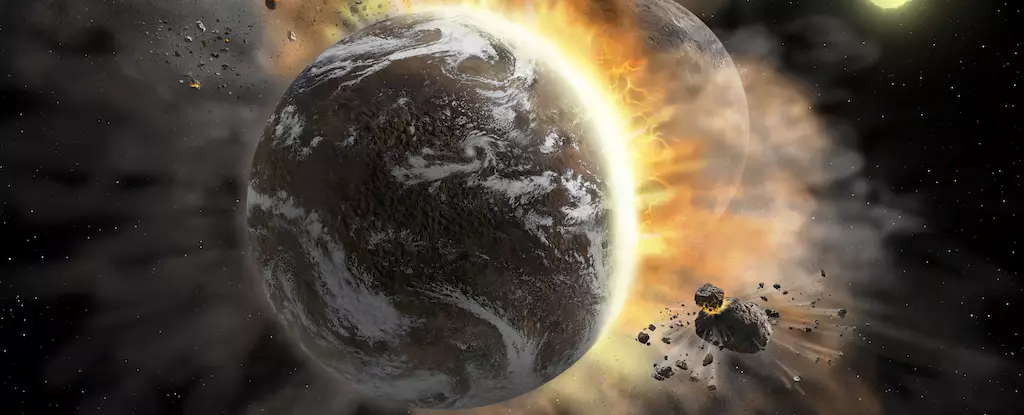The early ages of our Solar System were a tumultuous era, characterized by violent collisions and an environment reminiscent of chaos. Observations of celestial bodies, particularly our Moon, serve as a time capsule showcasing the relentless impacts that shaped it: its heavily cratered surface tells tales of countless collisions. These ancient phenomena are not isolated occurrences, but instead serve as a lens through which we can comprehend the formative periods of other planetary systems across the galaxy. Recent studies highlight the chaotic nature of young solar systems, allowing scientists to simulate planetary collisions that may reveal truths about their evolution.
Unpacking the Mass of Exoplanets
Among the most striking findings from these simulations is the revelation that some exoplanets could house immense cores exceeding 100 Earth masses. This staggering mass often results from iterative collisions and mergers with smaller protoplanets, each contributing solid material and enriching the resultant giant planets with metals. These processes are not mere whims of chance; they define the architectural framework of planetary systems and dictate their potential for fostering complex environments. The research underscores the intricate balancing act between gravity, collision dynamics, and material amalgamation that governs planet formation.
Investigating Seismic Oscillations
A recent groundbreaking study led by theoretical physicist J.J. Zanazzi examined the seismic consequences of giant impacts in a young gas giant and their potential detectability by the James Webb Space Telescope (JWST). The dual questions posed in this inquiry are critical in advancing our understanding of celestial mechanics: Can a colossal impact produce enduring seismic waves, and can the JWST detect such phenomena? While the JWST is not equipped to measure seismic waves directly, its sensitivity to variations in light allows it to identify changes induced by these seismic activities, positioning it as a novel investigative tool for planetary geophysics.
Zanazzi’s team honed in on Beta Pictoris b, an exceptional exoplanet that defies easy categorization. With a mass roughly 13 times that of Jupiter and an age of merely 12 to 20 million years, it stands as a vital subject for this research. Findings from earlier studies have revealed that the planet is rich in metals, attributed to a process termed “strong planetesimal enrichment.” This leads to further exploration of how substantial impacts can enrich a planet’s composition and enhance our understanding of its internal structure.
The Role of Seismic Activity
Calculations reveal that a simulated merger between Beta Pictoris b and a smaller Neptune-mass planet yields poignant results: the collision would not only merge their respective masses but also invigorate seismic activity that could endure over multiple million-year timescales. The researchers predict that if an impactful event transpired within the last 9 to 18 million years, it would result in observable fluctuations in the planet’s luminosity. Herein lies a fascinating intersection between astrophysics and seismology—if seismic oscillations can be detected photometrically, it offers unprecedented insights into the gas giant’s geology and internal structures.
In terms of scientific implications, the ability to harness seismic observations can yield direct insight into the composition and characteristics of giant planets. As the researchers noted, “Seismology offers a direct window into giant planet interiors.” This observation opens doors to a deeper understanding not just of the individual planets themselves, but of the conditions that dictate their formation and evolution.
Beyond Detection: Inferring Planetary Behavior
The ramifications of this research extend beyond merely probing planetary interiors. The methodology could illuminate the migration behavior of various exoplanets, elucidating how interactions with their host stars can influence their orbital dynamics. Such complexities shed light on the diverse evolutionary paths planets might take under varying gravitational influences. Impacts, migration, and their interplay are just a few factors contributing to a planet’s life history, hinting at a fevered activity that could illuminate the formative years of a planetary system.
As the scientists put forth, understanding the implications of oscillations excited by tidal forces from host stars provides an avenue to recognize patterns of planet formation, painting a broader picture of cosmic architecture. This integrated approach to celestial mechanics paves the way for further explorations, utilizing the capabilities of advanced instrumentation like JWST to peer into the complexity of the cosmos.
In essence, these innovations in research underscore a thrilling era in astrophysical science. As we unveil the seismic secrets hidden within distant giant planets, we not only expand our comprehension of their formation but also glean insights into the energetic processes that may govern life-changing events across the universe.


Leave a Reply